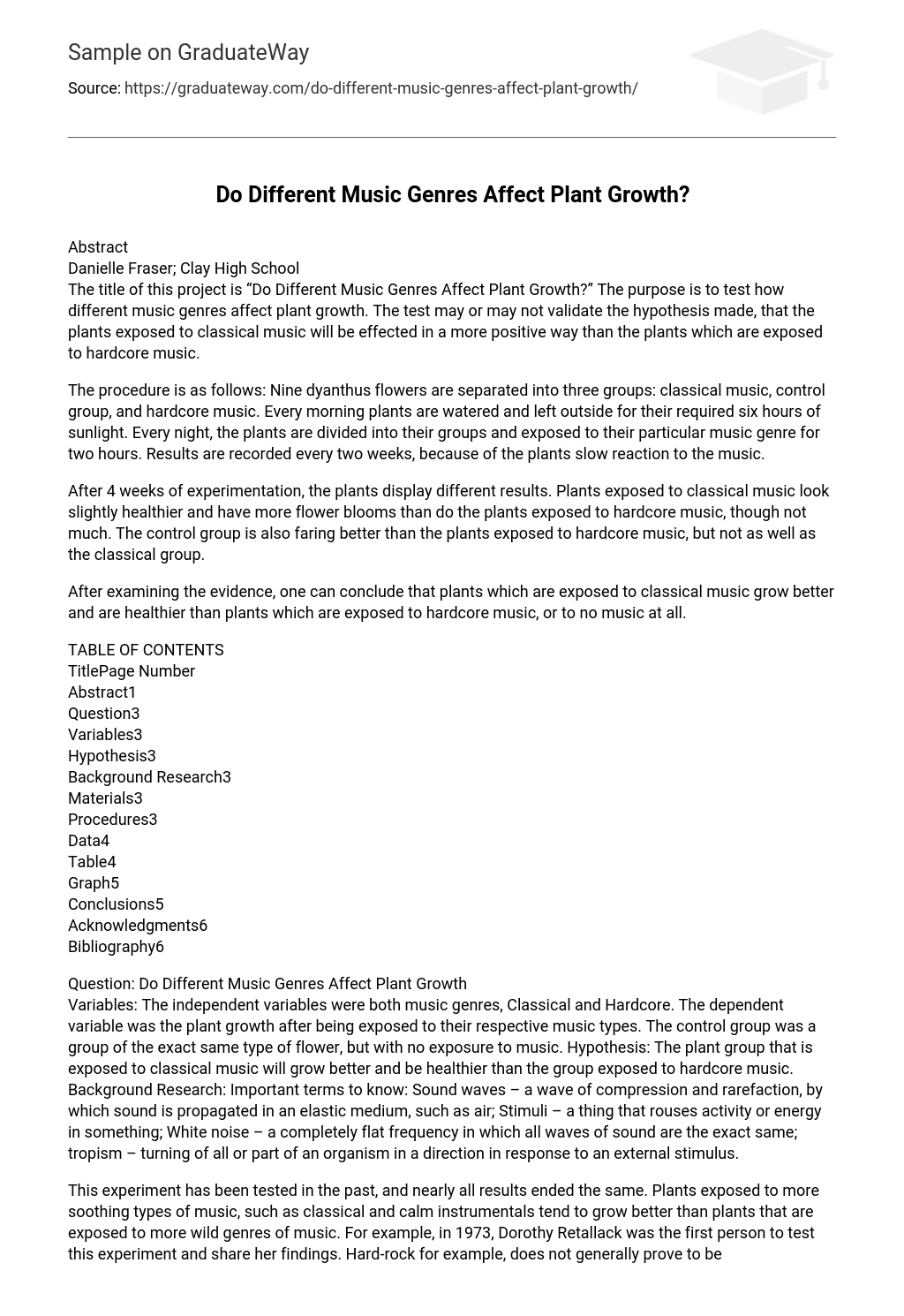Introduction
The purpose is to test how different music genres affect plant growth. The test may or may not validate the hypothesis made, that the plants exposed to classical music will be effected in a more positive way than the plants which are exposed to hardcore music.
Nine dyanthus flowers are separated into three groups: classical music, control group, and hardcore music. Every morning plants are watered and left outside for their required six hours of sunlight. Every night, the plants are divided into their groups and exposed to their particular music genre for two hours. Results are recorded every two weeks, because of the plants slow reaction to the music.
After 4 weeks of experimentation, the plants display different results. Plants exposed to classical music look slightly healthier and have more flower blooms than do the plants exposed to hardcore music, though not much. The control group is also faring better than the plants exposed to hardcore music, but not as well as the classical group.
After examining the evidence, one can conclude that plants which are exposed to classical music grow better and are healthier than plants which are exposed to hardcore music, or to no music at all.
The independent variables were both music genres, Classical and Hardcore. The dependent variable was the plant growth after being exposed to their respective music types. The control group was a group of the exact same type of flower, but with no exposure to music. The plant group that is exposed to classical music will grow better and be healthier than the group exposed to hardcore music.
This experiment has been tested in the past, and nearly all results ended the same. Plants exposed to more soothing types of music, such as classical and calm instrumentals tend to grow better than plants that are exposed to more wild genres of music. For example, in 1973, Dorothy Retallack was the first person to test this experiment and share her findings. Hard-rock for example, does not generally prove to be good for plant development. She concluded that plants react better to softer, nicer music, such as classical.
Materials
Nine Dyanthus plants, water, ipod and speakers, CD player, camera Procedure: Nine plants are divided into three separate groups. These groups are Classical music, Hardcore music, and the Control group, which does not get any music exposure. Every morning, the plants are watered and left outside to get their required six hours of sunlight daily. Every night they are divided into their groups and exposed to their particular music genre for two hours. Every two weeks, the growth of each group of plants is recorded.
Data
After four weeks of experiemtnation, each group of plants has slightly changed. The group exposed to classical music look healthier and have more flower blooms than the other two groups, though not by much. The control group is also faring better than the hardcore group, but not as well as the classical group. The plants exposed to hardcore music are wilting, with bent stems and dying flower blossoms.
Conclusions
After examining the evidence, one can conclude that plants which are exposed to classical music fare better than plants which are exposed to hardcore music, or plants with no music exposure at all. The reason for this, being that plats react better to different types of vibrations. Vibrations from classical music are generally changing, whether it be in intensity, frequency or otherwise.
Changing vibrations are what plants respond best to. White noise however, has a negative impact on the plants. White noise is produced by hardcore music, because it is, for the most part, steady and constant noise and vocals, that are usually pretty harsh. It can also believed, because of the all around poor condition of the plants after experimentation, including the control group, that the results may have been affected by the abnormally cold whether experienced during the testing period. Acknowledgments:
I would like to acknowledge my mother, Theresa Boatright, for all of her help in conducting this experiment and in helping me attain the materials needed to conduct this experiment. She drove me all around town to different Walmart’s and Home Depot’s so I could find some nice flowers to test on. Thanks, Mom! ~Danielle Fraser
Bibliography
- Buzzle.com. N.p., 2011. Web. 5 Dec. 2012.
- “How Do Different Types of Music Affect Plant Growth?” Info.com. N.p., 2012. Web. 5 Dec. 2012.
- “White, Pink, Blue and Violet: The Colours of Noise.” Duncun Geere, 7 Apr. 2011. Web. 5 Dec. 2012. .
- Tropism.” Biology Online. N.p., 5 Oct. 2005. Web. 5 Dec. 2012.





